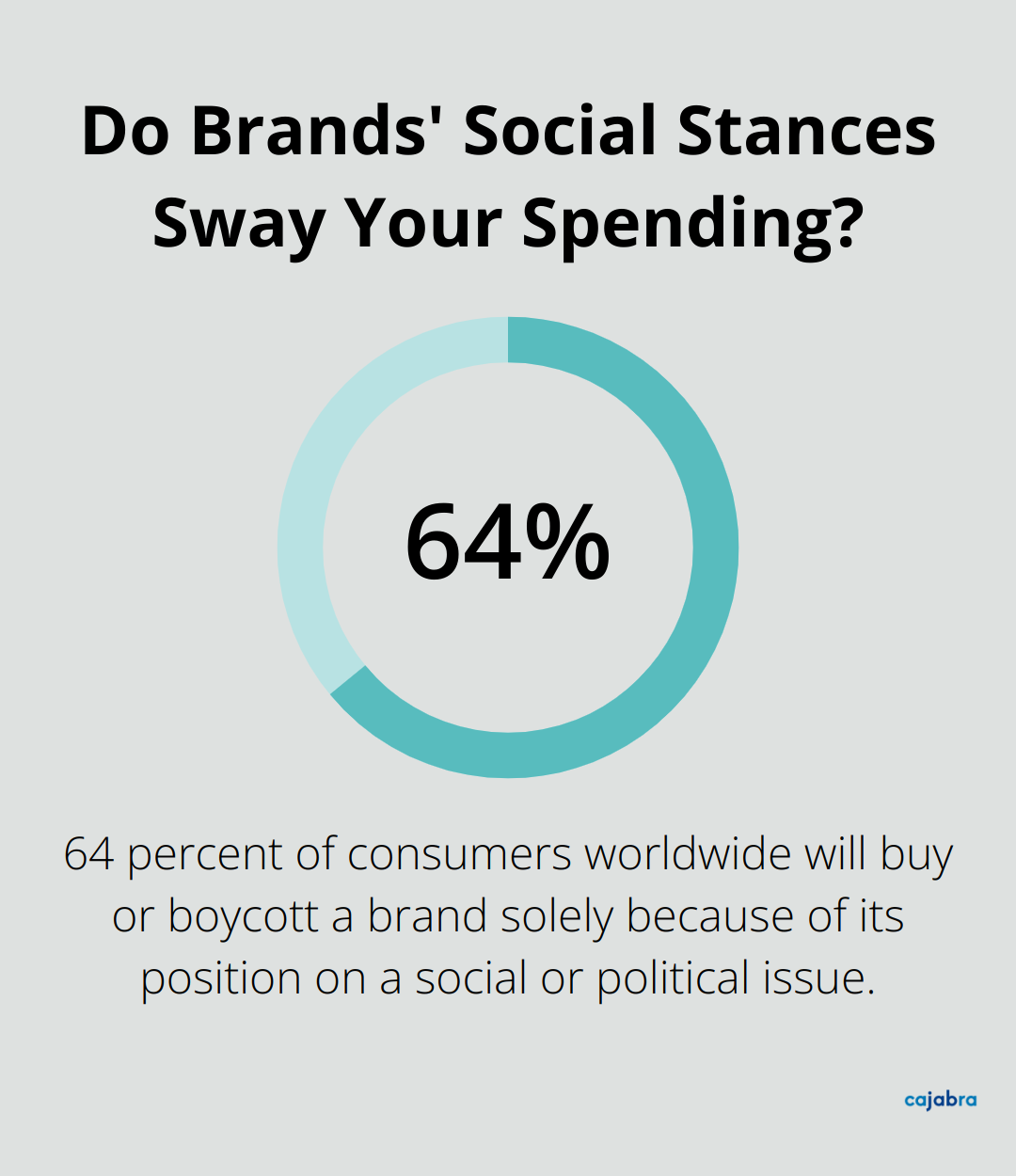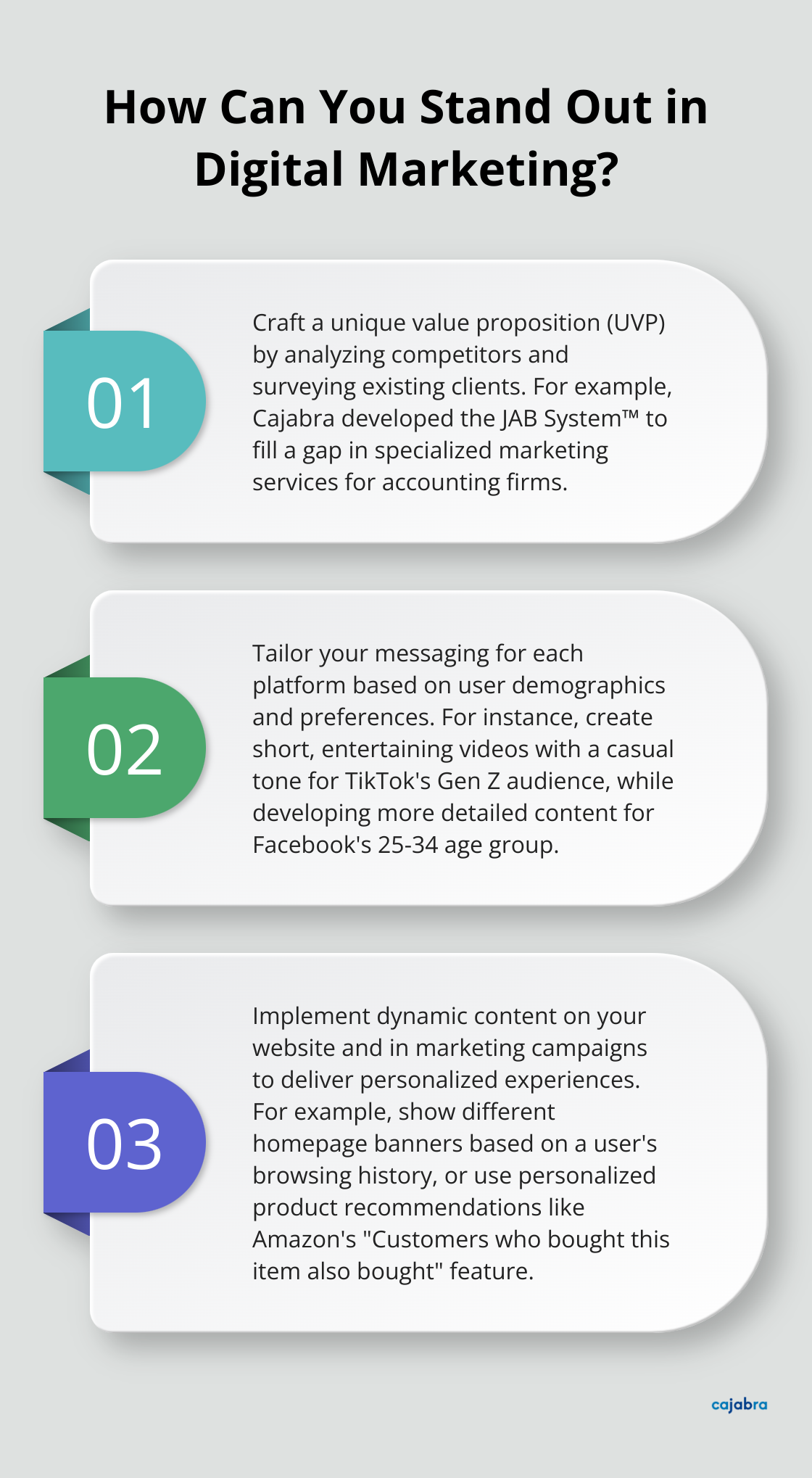
Effective messaging is the cornerstone of business growth in today's competitive landscape. At Cajabra, LLC, we've seen firsthand how the right communication strategy can transform a company's trajectory.
This post explores messaging strategy examples that have proven successful for businesses across various industries. We'll guide you through crafting compelling brand stories, leveraging multi-channel communication, and personalizing your approach to resonate with your target audience.
To identify your unique value proposition (UVP), start by analyzing your competitors. What do you offer that they don't? For example, Cajabra developed the JAB System™, recognizing a gap in the market for specialized marketing services tailored to accounting firms. This system became their UVP, promising to move accountants from overlooked to overbooked in just 90 days.

Next, survey your existing clients. Ask them why they chose your business over others. Their responses often reveal strengths you might have overlooked. A study by Edelman found that nearly two-thirds (64 percent) of consumers around the world will buy or boycott a brand solely because of its position on a social or political issue. This insight can help you align your UVP with your audience's values.
Once you've identified your UVP, communicate it consistently across all platforms. Create a brand voice guide that outlines your tone, language, and key messages. Share this guide with all team members involved in customer communication.
For instance, MailChimp's voice guide describes their tone as "plain-spoken, genuine, and dry," which perfectly aligns with their brand identity. This consistency has contributed to their growth to over 12 million active customers.
Emotional connections drive customer loyalty. A study by the Harvard Business Review found that emotionally connected customers are more than twice as valuable as highly satisfied customers over their lifetime.
To create these connections, focus on storytelling. Share your company's origin story, highlight customer success stories, and showcase your team's personalities. Airbnb does this effectively through their "Stories from the Airbnb Community" series, which features real hosts and travelers, fostering a sense of belonging among their users.
Another powerful technique aligns your brand with a cause. TOMS Shoes built their entire brand around their "One for One" giving model, donating a pair of shoes for every pair purchased. This approach not only differentiated them in the market but also created a strong emotional bond with socially conscious consumers.
Your brand story isn't static. It should evolve with your company and your audience. Regularly revisit and refine your narrative to ensure it remains relevant and resonant. A compelling brand story that highlights your unique value, maintains consistency, and forges emotional connections creates a strong foundation for business growth.
Now that we've explored how to craft your brand's unique story, let's examine how to effectively communicate this story across multiple channels.
Effective communication across multiple channels drives business growth in today's digital landscape. A well-executed multi-channel strategy boosts engagement and conversions significantly.
Different platforms have unique characteristics and user behaviors. LinkedIn users expect professional content, while Instagram thrives on visual storytelling. According to The Sprout Social Index™ 2022, 73% of Gen Z consumers think it's important for brands to amplify their beliefs and values. This fact underscores the importance of adapting your message while maintaining brand consistency.

To tailor your message effectively:
For example, TikTok's user base (predominantly Gen Z, with 60% of users between 16-24 years old) responds well to short, entertaining videos with a casual tone. In contrast, Facebook's largest age group (25-34) suits more detailed content and community engagement.
While digital channels dominate, offline messaging still plays a vital role in many industries. Create a seamless experience across all touchpoints. Starbucks exemplifies this approach with their mobile app that integrates with in-store purchases, creating a cohesive brand experience both online and offline.
For service-based businesses, blend digital and physical interactions. A law firm might use targeted social media ads to drive potential clients to book in-person consultations. This approach combines the reach of digital platforms with the personal touch of face-to-face meetings.
Data-driven insights optimize your multi-channel strategy. Tools like Google Analytics reveal which channels drive the most traffic and conversions to your website. Social media platforms also offer robust analytics that help you understand engagement rates and audience demographics.
A McKinsey study found that companies using data-driven personalization delivered five to eight times the ROI on marketing spend. This finding highlights the importance of not just collecting data, but actively using it to refine your strategy.
To optimize your channels:
For instance, if your email campaigns have a higher conversion rate than your social media ads, allocate more resources to email marketing.
Effective multi-channel communication identifies the most impactful channels for your business and optimizes your presence on those platforms. The next chapter will explore how to personalize your messaging strategy to resonate with your target audience on a deeper level.
Personalization is not a luxury in marketing-it's a necessity. A study by Epsilon found that 80% of consumers are more likely to make a purchase when brands offer personalized experiences. This chapter explores how you can implement personalization in your messaging strategy to drive business growth.
Effective personalization starts with segmentation. Divide your audience into groups based on shared characteristics such as demographics, behavior, or preferences. This allows you to tailor your messages to each group's specific needs and interests.

For example, a software company might segment its audience into small businesses, mid-sized companies, and enterprises. Each segment would receive messages highlighting features and benefits most relevant to their size and needs.
To implement segmentation:
Netflix uses viewing history to create micro-segments, allowing them to recommend shows with remarkable accuracy. This personalized approach has contributed to their impressive customer retention rate.
Buyer personas take segmentation a step further by creating fictional representations of your ideal customers. These detailed profiles help you understand your audience on a deeper level, allowing for more targeted and effective messaging.
To create effective buyer personas:
HubSpot's research shows that using marketing personas made websites more effective and easier to use by targeted users. This demonstrates the power of truly understanding your audience.
Dynamic content adapts based on user data, behavior, or preferences. It's a powerful tool for delivering personalized experiences at scale.
For instance, an e-commerce site might show different homepage banners based on a user's browsing history. A first-time visitor might see a general welcome message, while a returning customer who previously viewed running shoes would see promotions for athletic gear.
Amazon excels at dynamic content, with product recommendations driving a significant portion of their revenue. Their "Customers who bought this item also bought" feature is a prime example of how dynamic content can boost sales through personalization.
To implement dynamic content:
Personalization is an ongoing process. You should regularly review your data and adjust your strategies to ensure your messaging remains relevant and effective. These personalization techniques will help you create more engaging, targeted messages that resonate with your audience and drive business growth.
Effective messaging strategies form the foundation of successful business growth. The examples we've explored, from crafting compelling brand stories to personalizing communication, play vital roles in connecting with audiences and driving results. These strategies help businesses stand out, build trust, and turn customers into loyal advocates.

A multi-channel approach tailored to each platform maximizes reach and impact in today's digital landscape. Bridging online and offline messaging creates a seamless customer experience, reinforcing brand identity at every touchpoint. Personalization takes messaging strategies to new heights, significantly increasing engagement and conversions through audience segmentation and dynamic content.
At Cajabra, we apply these messaging strategy examples to help accounting firms transform their businesses. Our specialized marketing services assist accountants in moving from overlooked to overbooked in just 90 days. We encourage you to implement these effective strategies in your own business, starting with an evaluation of your current approach and gradually incorporating these techniques.



